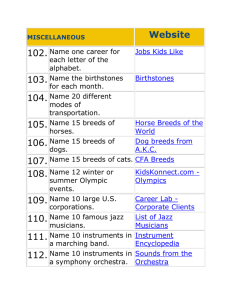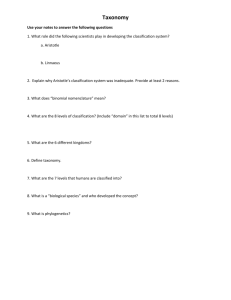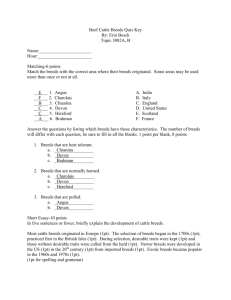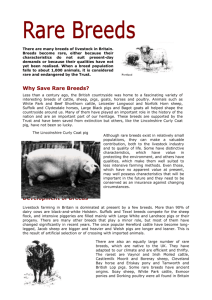Lesson 5A - Taxonomy and Breeds
advertisement
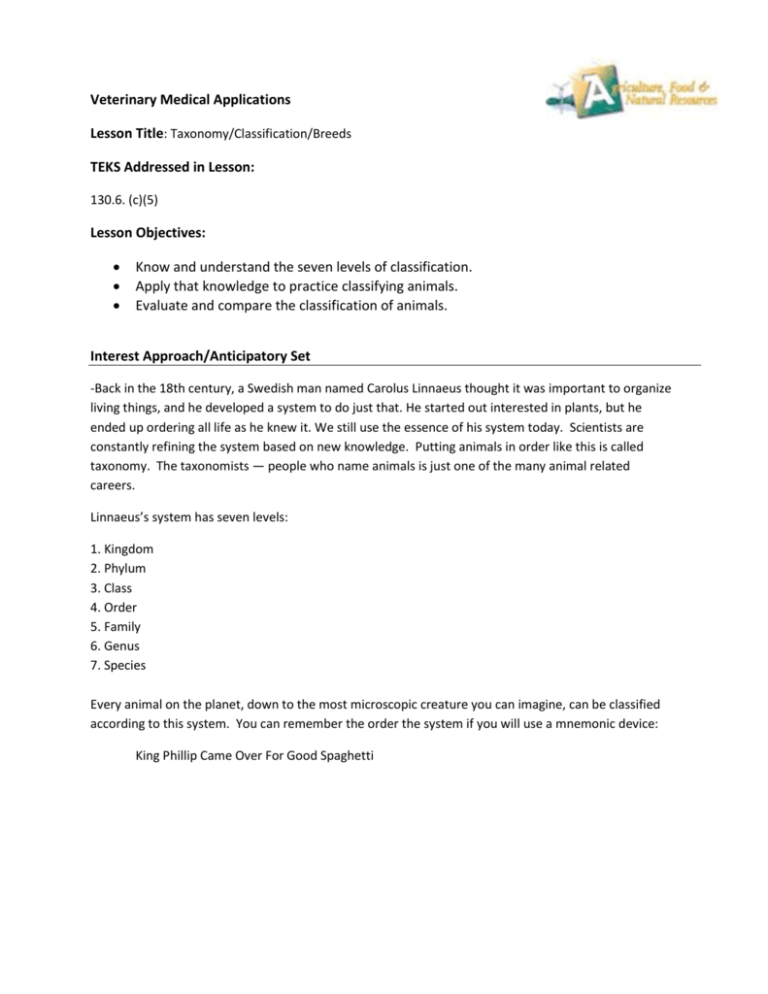
Veterinary Medical Applications Lesson Title: Taxonomy/Classification/Breeds TEKS Addressed in Lesson: 130.6. (c)(5) Lesson Objectives: Know and understand the seven levels of classification. Apply that knowledge to practice classifying animals. Evaluate and compare the classification of animals. Interest Approach/Anticipatory Set -Back in the 18th century, a Swedish man named Carolus Linnaeus thought it was important to organize living things, and he developed a system to do just that. He started out interested in plants, but he ended up ordering all life as he knew it. We still use the essence of his system today. Scientists are constantly refining the system based on new knowledge. Putting animals in order like this is called taxonomy. The taxonomists — people who name animals is just one of the many animal related careers. Linnaeus’s system has seven levels: 1. Kingdom 2. Phylum 3. Class 4. Order 5. Family 6. Genus 7. Species Every animal on the planet, down to the most microscopic creature you can imagine, can be classified according to this system. You can remember the order the system if you will use a mnemonic device: King Phillip Came Over For Good Spaghetti Teaching Plan and Strategy Presentation of New Material Kingdom: Generally, scientists agree there are six kingdoms. Originally, Linnaeus only identified two kingdoms: plant and animal. Phylum: Within the animal kingdom, the animals are divided into more than 30 Phyla. Phylum Chordata – includes humans and all animals with backbones. Class: The third level of classification is Class. Order: The next level is Order. Orders are smaller groups within the different classes. Carnivora is the order within Mammalia that has the most diversity in animal size. Family: The fifth rank of classification is Family. The family for dogs is Canidae. Genus: A Genus may have only one or two animals in it. If animals are in the same genus, they are really closely related. When we write the name of the genus, we capitalize it and italicize it. For example, the genus of dogs (and wolves) is Canis. Species: If animals can breed together successfully, they are a Species. When an animal is called by its scientific name, then that means it is being identified by its genus and species. We use a lowercase letter and italics for the species. The scientific name of dog is Canis familiaris; however, the scientific name of wolves is Canis lupus. Activity/Application/Student Engagement/Laboratory Practice writing Scientific Names on student notes sheet Devise a classification system for the objects in their homes. Students should list no less than 25 items they have in their room or in their home. Students should develop a classification system for these items in order to make sense of the classification system. Create a new species and classify it according to the principles of classification. Students should draw and describe their animal and list it’s seven levels of classification. Breeds Research Project For this lesson, you will need: Pictures of a variety of animals General research materials on animals (e.g., biology books, encyclopedia) Computer with Internet access Breeds Project Requirements: Use PowerPoint, Prezi, or any other presentation software to compose a Breeds Presentation in order to teach your classmates about your specie. You must include the following information: o Basic Information o Breeds of this specie How many List and show at least 10 (EC for more) Color, size, common problems of this breed If this breed is more desirable If you have cattle discuss Continental Breeds as well as Exotic Breeds If you have dogs discuss the AKC Groups Cats discuss DSH and DLH o Digestive info What this animal eats What type of digestive system Reproduction Mate for life? Gestation period? How many offspring How long is the offspring with them after birth? o Behavior Preferred environment Uses Temperament o Care of this Animal o Interesting Information o Must have background, transitions, pictures and effects!! Students should take notes over peer presenations. Evaluation/Summary Student Presentation Breeds/taxonomy quiz References/Additional Materials/Extended Learning Opportunities/Enrichment The World Book Encyclopedia of the Animal World Intro to Veterinary Medicine, Thompson College and Career Readiness Standards: Science I. A-E VI. A-G




